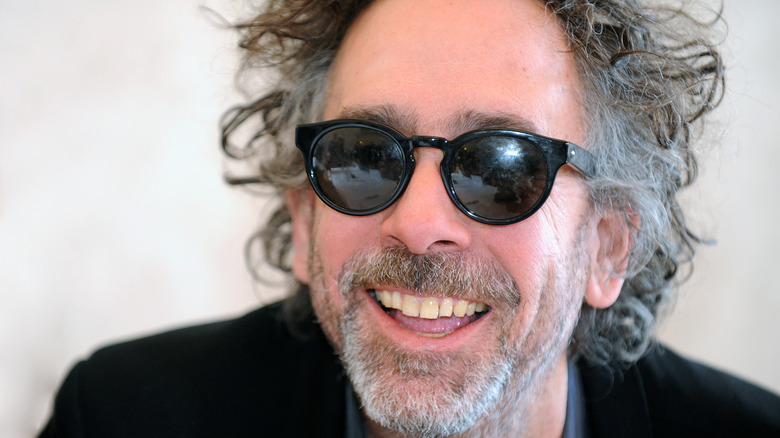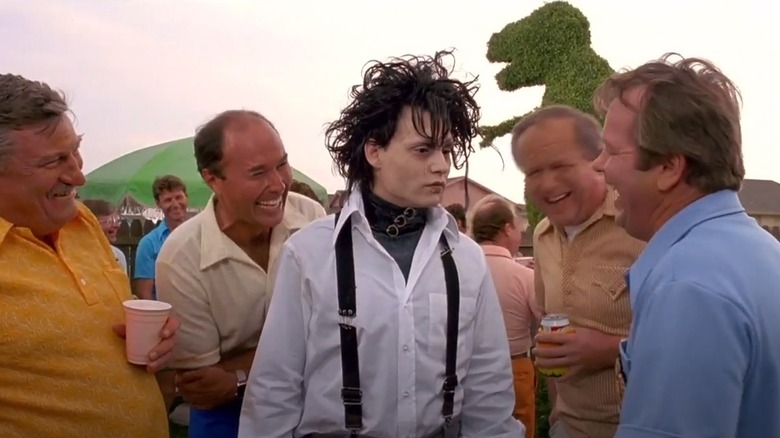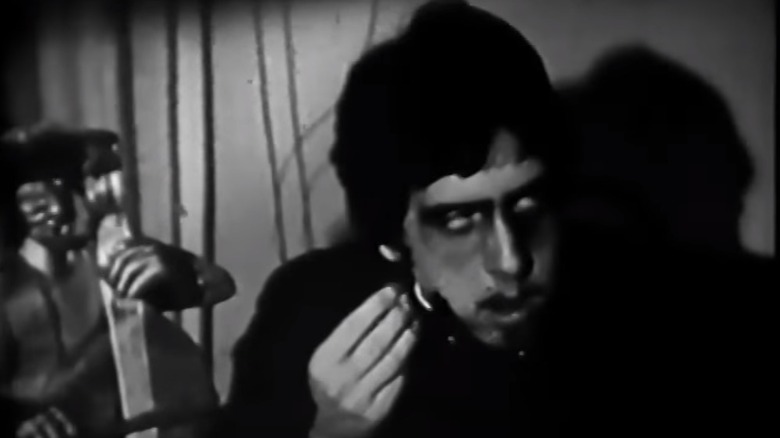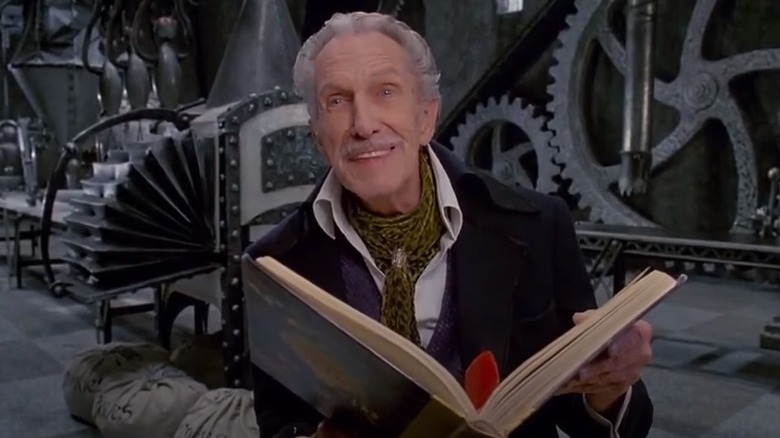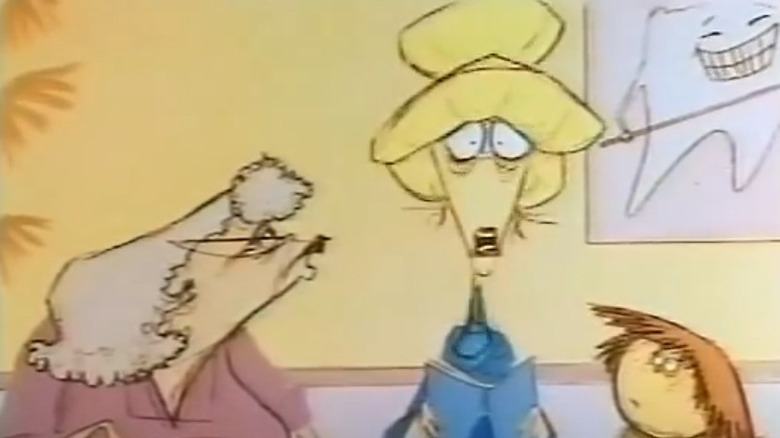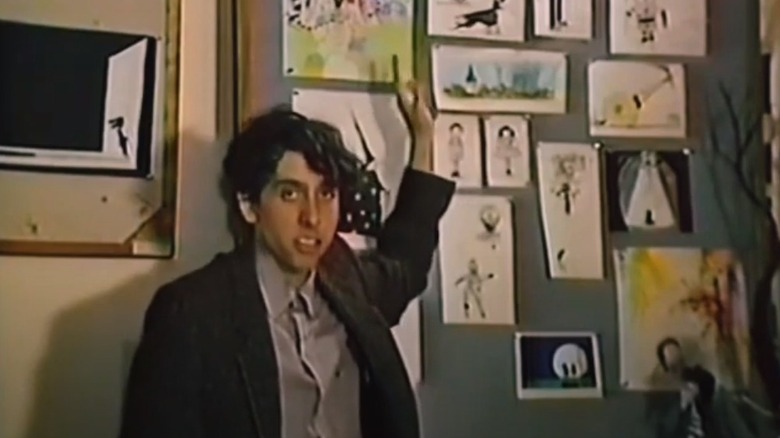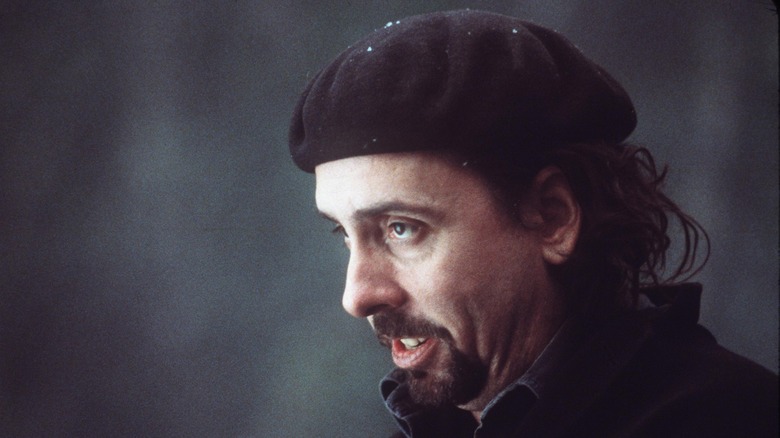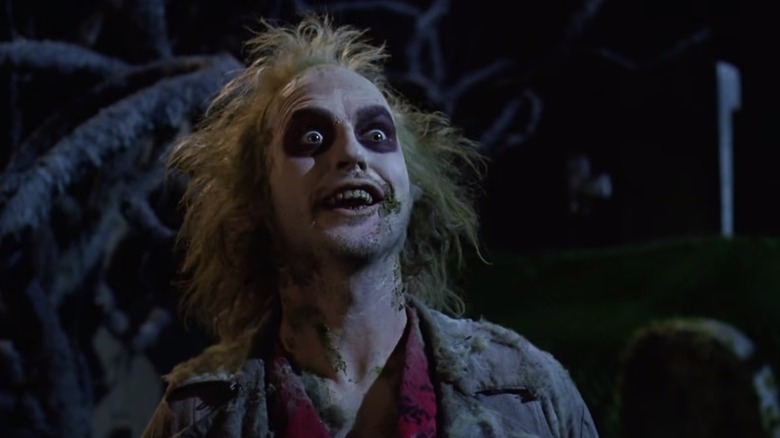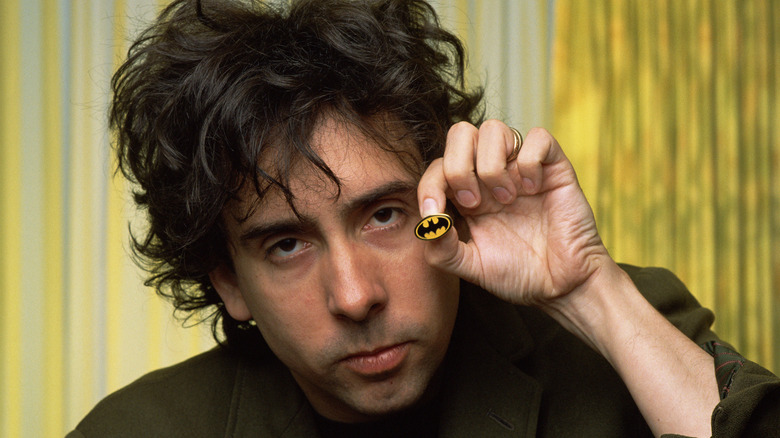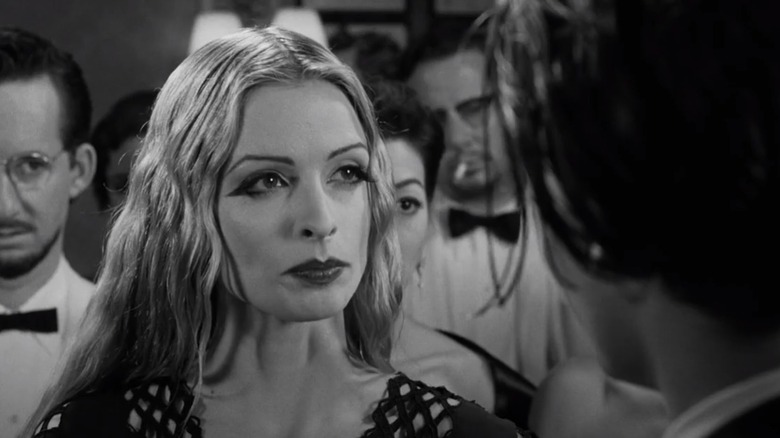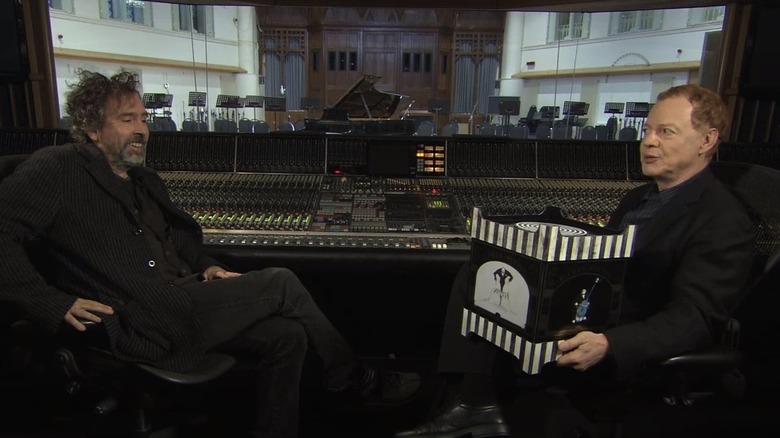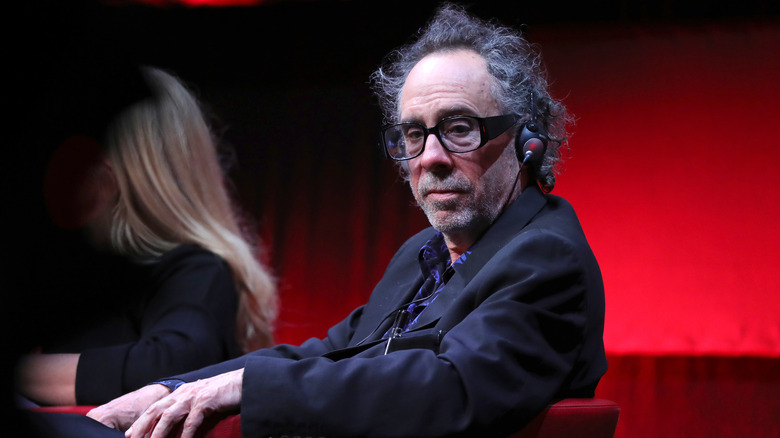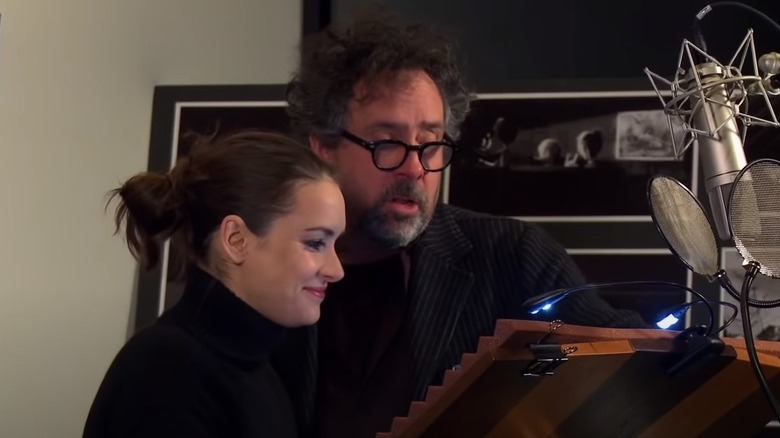The Untold Truth Of Tim Burton
For nearly four decades, filmmaker Tim Burton has brought his unique brand of dark whimsy to movie screens to the delight of fans the world over. From the paranormal hijinks of "Beetlejuice" to the Gothic terrors of "Sleepy Hollow" to the heartfelt tall tales of "Big Fish," Burton has followed his melancholy muse to places off-kilter, and sometimes, frightening. A self-professed weirdo, Burton has spun his unique obsessions with art, classic monster movies, and suburban life into one of the most distinctive oeuvres of any filmmaker working today. Dabbling in horror, surrealism, and dark comedy, his work is virtually a genre unto itself occupying an unlikely middle ground between "The Cabinet of Dr. Caligari" and Walt Disney. Defying all odds, Burton's haunted funhouse aesthetics have struck a chord with mainstream audiences, making him among the most bankable directors in recent Hollywood history.
Yet, behind his signature mop of black hair and oversized sunglasses is the soul of an artist with little regard for the system that's made him a household name. An outsider once rejected by the industry that has come to embrace him as a reliable moneymaker and crowd pleaser, Burton, who has likened filmmaking to therapy, continues to make movies his way. The results have ranged from emotionally-wrought masterpieces such as "Edward Scissorhands” to visually arresting but hollow misfires like his 2012 reworking of the 1960s' horror soap opera "Dark Shadows."
Turn down the lights and put on something black. This is the untold truth of Tim Burton.
Outsider in suburbia
As detailed in "Burton on Burton," Tim Burton was born August 25, 1958 in Burbank, California. His father, Bill Burton, a former minor league baseball player, worked for the Burbank Parks and Recreation Department. His mother Jean "Rickie" Burton worked part time in a photo lab and later ran a feline-themed gift shop called Cats Plus.
Although Burbank, located in the San Fernando Valley just 12 miles from downtown Los Angeles, is a hub for the entertainment industry and home to Warner Brothers, NBC, and Walt Disney Studios, the suburban city was anything but glamorous to a young, artistic outsider like Tim Burton. "[In] Burbank, California, there's no seasons. It's kind of like growing up on an empty canvas," Burton told MTV in the 1994 documentary "Freaks, Nerds, and Weirdos." "You're forced to create your own world."
Growing up, an introverted Burton often felt alienated from his peers and sought refuge from the banality of suburban life in movies and television. Classic horror such as "Dracula" and "The Bride of Frankenstein" and '70s grindhouse and exploitation shockers like "Scream, Blacula, Scream," and "Dr. Jekyll and Sister Hyde" shaped his sense of aesthetics and substituted for a social life. "I didn't have a lot of friends," he explains in "Burton on Burton," "but there's enough weird movies out there so you can go a long time without friends and see something new every day that kind of speaks to you."
Budding filmmaker
Hooked on horror, 10-year-old Tim Burton spent his allowance on monster magazines and tickets to the latest fight flicks playing at one of Burbank's many local movie houses. While many kids growing up in the suburbs aspired to be doctors, police officers, or astronauts, Burton, had a very different idea of what he wanted to be when he grew up — according to a 2001 episode of A&E's "Biography," he wanted to be the actor inside Godzilla.
With his younger brother, Daniel, Burton would spend hours sketching his favorite movie monster. Art would continue to be an important part of Burton's life throughout high school where, believe it or not, the future "Edward Scissorhands" director became something of a jock as a valued member of the water polo and swim teams. Still, it was Burton's artistic skills that garnered him his first taste of fame. "Burton on Burton" explains that in the ninth grade, his design for an anti-litter campaign won first place in a city-wide contest. Burton's art adorned Burbank garbage trucks for two months.
Burton also began to experiment with filmmaking and animation. "Together with a group of friends I would make Super 8 movies," the director says in "Burton on Burton." "There was one we made called 'The Island of Doctor Agor.' We made a wolfman movie, and a mad doctor movie, and a little stop-motion film using model cavemen." A poor student who had little interest in reading, Burton soon found he could use filmmaking to improve his grades.
Tim Burton idolized Vincent Price
No figure looms larger in Tim Burton's imagination than the legendary "master of menace," Vincent Price. Specifically, the Edgar Allan Poe-inspired films Price made in the 1960s had a profound effect on the young horror fan's psyche. "There was a connection, an emotional link for me, growing up and watching the Poe films." Burton told Price's daughter Victoria, author of "Vincent Price: A Daughter's Biography." He said, "Vincent's characters had a sensitivity. There was an energy he had. It was evident in everything... "
To Burton, Price's characters weren't mere unhinged madmen, they were, in their macabre elegance, sensitive but tortured outsiders driven to commit heinous acts by internal forces that they could not control. As an adolescent who never quite fit in, Burton saw in Price a kindred spirit.
"Burton on Burton" reports that while working as a concept artist for Disney in the early 1980s, Burton channeled his love of Price into a poem titled "Vincent." Written in a style reminiscent of Dr. Seuss, "Vincent" tells the story of Vincent Malloy, an imaginative 7-year-old boy who "wants to be just like Vincent Price." As documented in "Burton on Burton," the director initially intended "Vincent" to be a children's book. However, some supportive allies at Disney gave Burton a small amount of money to produce "Vincent" as a short film under the pretense that it was a stop motion "test" film. Burton was able to bring on his childhood idol to narrate the five-minute film, beginning a friendship that would last until Price's death in 1993.
A leafy green terror leads to a job
As documented in "Burton on Burton," in 1978, 18-year-old Tim Burton was awarded a scholarship to attend the California Institute of the Arts. While at CalArts, Burton continued his Super 8 film experiments with his classmates mostly for fun. After deciding he needed to get serious about a career path, Burton joined CalArts' animation program. "I joined the second year of the Disney-funded programme," Burton explained (via "Burton on Burton".) "They were trying to teach all these eager young new recruits to be animators. It was like being in the Army. I've never been in the Army, but the Disney programme is probably about as close as I'll ever get."
In his third year at Cal Arts, Burton lost his scholarship. With his finances slim, he feared he would have to drop out. Fortunately, one of his projects, an animated film titled "Stalk of the Celery Monster," made the right impression on the right people at just the right time.
Where his classmates opted to use their short films to display their mastery of various animation techniques, Burton strived to make "Stalk of the Celery Monster" a fully realized and entertaining story. In the film, a mad scientist and his hulking beast of an assistant perform macabre experiments on a helpless victim. At the climax, Burton reveals that the scientist is actually a dentist. "Stalk of the Celery Monster" caught Disney's attention, and in 1979, Burton went to work for the legendary animation studio.
Too weird for Disney
Scoring a job with Disney would have been a dream come true for most struggling CalArts animation students, but for Tim Burton the new gig was a nightmare.
As detailed by A&E's "Biography," Burton's first assignment was "The Fox and the Hound." "Disney and I were a bad mix. For a year I was probably more depressed than I have ever been in my life," Burton explains in "Burton on Burton." "...I got all the cute fox scenes to draw... I just couldn't do it. I couldn't even fake the Disney style. Mine looked like road kills." Burton had higher hopes for his next Disney project, "The Black Cauldron." Hired as a conceptual artist, Burton was free to let his imagination run wild drawing witches and monsters. Disney, however, found Burton's work incompatible with the studio's style and chose not to use his work.
Luckily, Burton's talents didn't go completely unnoticed. His work impressed Disney executive Julie Hickson and Head of Creative Development Tom Wilhite, who gave him the funds to produce "Vincent." Burton followed his animated ode to Vincent Price with a bizarre, Japanese-inspired live action production of "Hansel and Gretel" for the Disney Channel.
Burton's next short, "Frankenweenie," was a suburban retelling of "Frankenstein" in which a young boy uses mad science to resurrect his recently deceased dog. It was the last straw for Disney. When "Frankenweenie's" dark tone earned it a PG rating, Disney shelved the film and sent Burton packing.
Burton hits the big time
With "Vincent" and "Frankenweenie" shelved, Tim Burton had mixed feelings about his time at Disney. He had finally been allowed the creative freedom he craved, but no one outside the industry could see his work. "Burton on Burton" explains that following his exit from the studio, Burton was approached by one of his "Frankenweenie" stars, actress Shelley Duvall. At the time, Duvall was the creative force behind the award-winning Showtime children's series "Faerie Tale Theater." At Duvall's request, Burton directed the 1986 episode "Aladdin and His Wonderful Lamp" starring Robert Carradine, Leonard Nimoy, and James Earl Jones.
According to Jim Smith's "Tim Burton," the director found his experience shooting "Faerie Tale Theatre" both technically and creatively frustrating. Dissatisfied with "Aladdin and His Wonderful Lamp," Burton bided his time and waited for his next project to materialize. Meanwhile, Burton's Disney work, not seen by the general public, was causing a stir in industry circles. Among those paying attention was comedian Paul Reubens. A former member of the Groundlings comedy troupe, which spawned such talents as Phil Hartman and Larraine Newman, Reubens was preparing to bring his popular Pee-Wee Herman character to the big screen. When he saw "Frankenweenie," he knew he had found a director with the right style to bring his manic man-child alter ego to life.
"Pee Wee's Big Adventure" was the surprise hit of the summer of 1985. Although critics were split on the film, it connected with its audience and made Tim Burton a director in demand.
The Beetlejuice that could have been
After "Pee Wee's Big Adventure," Tim Burton received numerous job offers, but none of them connected with the director. "I didn't work for a long time between 'Pee-Wee's Big Adventure' and 'Beetlejuice' because I just didn't want to do the things they were offering me," the director says in "Burton on Burton." "I was being offered any bad comedy... I even got offered 'Hot to Trot,' a talking horse movie!"
At last, producer David Geffen brought Burton some material that sparked his imagination: a script titled "Beetlejuice" written by Michael McDowell. Burton was familiar with McDowell's work, having directed his script for "The Jar" an adaption of a Ray Bradbury story for the '80s revival of "Alfred Hitchcock Presents." Attracted to the script's abstract imagery, strange characters, and lack of structure, Burton knew this weird comedy about a couple of ghosts who hire a "bio-exorcist" to remove the living from their home would be a showcase for his unmistakable visual style.
Although it's nearly impossible to imagine anyone other than Michael Keaton as the "ghost with the most," Burton originally had a much different actor in mind for the title role. "I wanted to cast Sammy Davis Jr. as Betelgeuse, but [Warner Brothers] nixed that idea," the filmmaker explains in "Burton on Burton." Comedian Sam Kinison and veteran actor Dudley Moore were also considered. Producer David Geffen eventually convinced Burton that Keaton was perfect for the role. The actor and director hit it off, leading Burton to cast Keaton in 1989's "Batman."
Comic book chaos
As documented in "Burton on Burton," the success of "Pee Wee's Big Adventure" led Warner Brothers to offer Burton "Batman." The studio had attempted to bring the popular DC Comics superhero to the screen for close to a decade with several directors attached at different times. Warners gave Burton the go-ahead to work on a script, but held off on greenlighting "Batman" until the first weekend's receipts were in from "Beetlejuice." When "Beetlejuice" proved to be a moneymaker, the studio set Burton on the path to his first blockbuster.
Although Burton loved the image of the Dark Knight and his nemesis, the Joker, he had never been a comic book fan. "I could never tell which box I was supposed to read," Burton explains. Despite his difficulty with the format, the director did find inspiration in Alan Moore's "The Killing Joke."
Burton's take on the Caped Crusader was a smash hit and a box office record breaker. Naturally, Warner Brothers brought him back for the sequel, 1992's "Batman Returns." Burton's return trip to Gotham was another box office success, however it came under fire from critics for its darker and more violent tone. A backlash from angry parents resulted in McDonald's distancing itself from its "Batman Returns" promotional tie-in campaign. "I think I upset McDonald's," Burton told Yahoo! Entertainment. "[They asked] 'What's that black stuff coming out of the Penguin's mouth? We can't sell Happy Meals with that!'"
A woman scorned
Having appeared as Maila "Vampira" Nurmi in "Ed Wood," the explosive Martian Girl in "Mars Attacks," the alluring and mysterious Lady Crane in "Sleepy Hollow," and the simian siren Nova in "Planet of the Apes," actress and model Lisa Marie is a familiar face to fans of Tim Burton's 1990s work. As reported by People, Marie and Burton began dating in December of 1991 and enjoyed a 10-year romantic relationship and business partnership. After moving in together, the couple decided to combine their earnings with Marie serving as Burton's personal manager. Burton also allegedly promised to support the actress for life.
However, Burton abruptly ended his relationship with Marie in August 2001. Unknown by Marie, Burton had been seeing actress Helena Bonham Carter on the set of "Planet of the Apes." Marie accepted a property settlement in 2004, but later she would claim the settlement was made in bad faith and she attempted to sue Burton for fraud. Marie also drew the director's ire when she auctioned a number of his personal effects including props, costumes, and memorabilia from his films in 2005. According to the CBC, a judge dismissed Marie's suit against Burton in 2008 citing that their original settlement was "valid and enforceable."
A volatile relationship with Danny Elfman
Tim Burton began his long creative partnership with composer Danny Elfman when he chose the former Oingo Boingo frontman to write the music for 1985's "Pee Wee's Big Adventure." Elfman has since gone on to score most of Burton's films to date.
From the beginning, Burton and Elfman enjoyed a synergistic creative relationship. Recalling their work on "Pee Wee's Big Adventure," Burton told Mark Salisbury, editor of "Burton on Burton," "We were definitely on the same wavelength. It was good because what he couldn't verbalize, or what I couldn't verbalize, didn't matter because it was there and he got it... If you find the right people, you're almost on a different level."
Still, Burton and Elfman's relationship has had its low points. The strain of working on back-to-back films caused a rift between the partners just prior to "Ed Wood." "In a quarter-century career, it's inevitable that two people like us would have a massive implosion," Elfman told the Guardian in 2013, "... I was very temperamental back then. And I regretted it soon after. It was like losing a sibling."
Fortunately, Burton and Elfman put their differences aside for "Mars Attacks" with both agreeing to never mention their falling out again.
Addams at last
Given Tim Burton's whimsically dark sense of aesthetics, it would seem that he was born to direct a project based on the macabre work of "New Yorker" cartoonist Charles Addams. Amazingly, fate and the mercurial nature of Hollywood conspired to keep Burton away from "The Addams Family."
In a 2021 Variety interview, "Addams Family" director Barry Sonnenfeld revealed that Burton was the first choice to direct the 1991 reboot. Although he was a natural for the project, Burton's commitment to "Batman Returns" prevented him from taking the director's chair. Burton was also rumored to be attached to a stop-motion animation version of "The Addams Family" in 2010. However, that project failed to materialize.
Thanks to Netflix, Burton is finally getting his shot at the creepy, kooky family with "Wednesday," set to premiere in 2022 (via Variety). The show, a supernatural mystery comedy, will focus on the adventures of a teenage Wednesday Addams portrayed by Jenna Ortega.
Tim Burton comes full circle
Disney may have dismissed Burton for his eccentric style, but it couldn't ignore the runaway successes of "Pee Wee's Big Adventure," "Beetlejuice," and "Batman." As detailed in "Burton on Burton," the studio jumped at the chance to work with the filmmaker when the opportunity arose. In 1993, Burton produced "The Nightmare Before Christmas" for Disney's adult-oriented Touchstone Pictures label, marking his triumphant return to the studio.
Burton has since produced or directed a number of films for Disney including "James and the Giant Peach" directed by "Nightmare's" Henry Sellick, a live action update of "Alice in Wonderland" starring Johnny Depp and Helena Bonham Carter, and its sequel "Alice Through the Looking Glass." Burton, who struggled with the Disney style as a fledgling animator, found himself directing a remake of the classic "Dumbo," and, in another stroke of irony, he produced and directed an all new, feature-length stop-motion version of "Frankenweenie," for Walt Disney in 2012.
